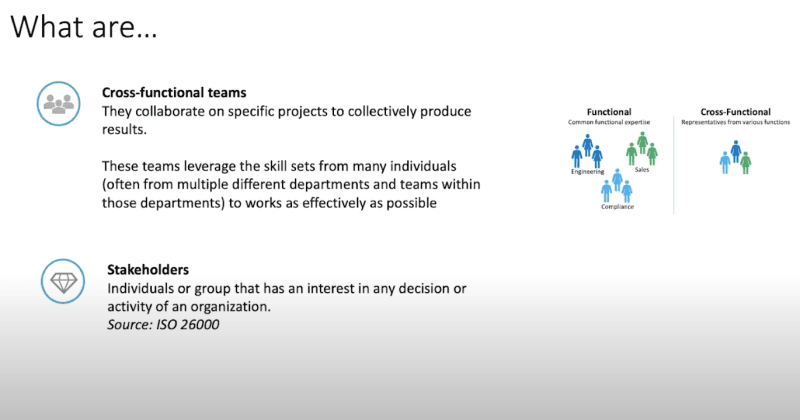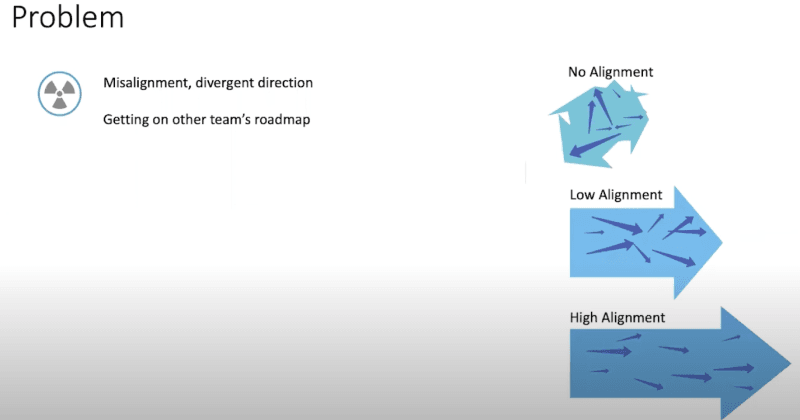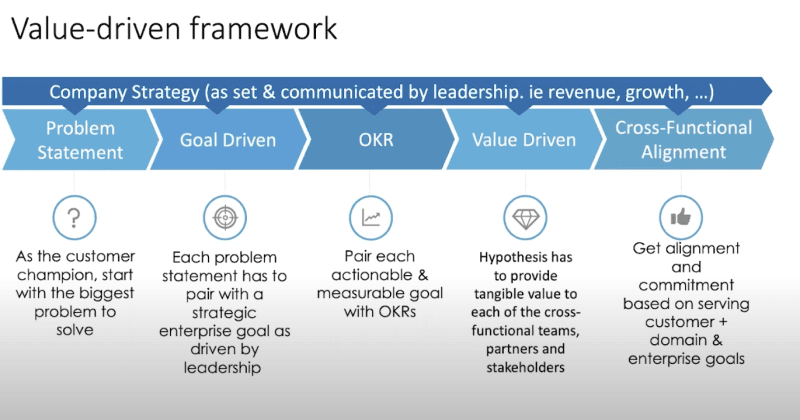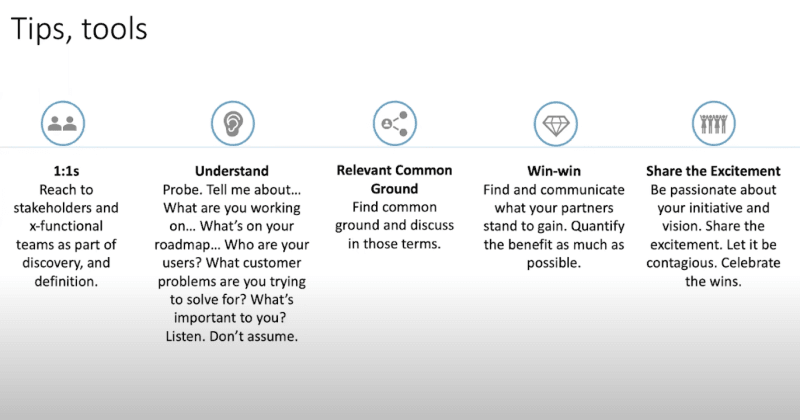Updated: June 18, 2025- 8 min read
Building alignment and ensuring everyone is on the same page? Now, that's a challenge! Coordinating everyone to work towards a common goal can be challenging, right? Especially when you're trying to align with other teams' roadmaps and there are interdependencies.
Editorial note: This post is based on a talk by Dawn Sheirzad, former PayPal Sr PM, on How to Lead Cross-Functional Teams and contains additional insights and examples from the Product School team. You can watch the webinar in full below.
Today, we'll discuss how to effectively influence and guide cross-functional teams to work together. From the common pitfalls to the must-know tips, we'll explore everything you need to lead your teams with confidence. We'll also shed light on value-driven frameworks – your ultimate tool in building and fostering alignment.

Understanding cross-functional teams and their dynamics
Ever heard the term "cross-functional teams" thrown around and wondered exactly what it means?
At its core, a cross-functional team is a collective of professionals, each wielding expertise from different domains, collaborating towards a shared objective. Imagine having someone from finance, security, compliance, and various other services, all in one room (or virtual meeting). These individuals might span different organizational tiers and could be scattered across continents, navigating different time zones and cultural nuances.
You might wonder, "Why such a diverse team?" Well, the strength of such teams lies in their diversity. Each member brings to the table their unique perspective, enriching the solution to a problem. But assembling such a team isn't always straightforward. Often, these professionals aren't part of a designated "team." As a product leader, it's your task to identify these key players, understand their roles, and engage them as stakeholders.

Now, let's delve into the term stakeholder. Essentially, stakeholders are individuals or groups with a vested interest in an organization's decisions or actions. Their motivations can vary. Consider the security team as an example: their primary goal might be to safeguard against threats, aiming for zero cyber-attacks, even if it means implementing rigorous checks that might slow down or frustrate a customer.

Imagine the most secure store ever. It's entirely locked down, with unbreachable doors. Sure, it's invincible to any threat, but what good is such security if customers can't access it? It's the equivalent of shutting down a business for absolute security. While it ensures zero threats, it stifles revenue and obstructs customers from accessing your products.
Balancing such dilemmas, like security vs. user experience or friction vs. revenue, is an art. And as product leaders, the challenge is to align these diverse stakeholders, ensuring everyone rows in the same direction. And that, dear leaders, is the key of mastering cross-functional team dynamics.
Problem statement: Misalignment, divergent direction, and getting in other teams’ roadmaps
Common challenges across cross-functional teams are team misalignment, divergent goals, and the hurdle of integrating with other teams' roadmaps. Ever wondered how to effectively influence these dynamics without constantly having to escalate issues? Or how to lead with inspiration rather than imposition?

This issue isn't exclusive to large corporations. Even in smaller organizations, these challenges persist. Imagine a well-oiled machine where every component, or in our case, team members and units, move in perfect synchronization. They're all aligned towards a common goal, collaborating to address the problem statement with the right capabilities at just the right time. That's the ideal, and it's achievable in a highly aligned organization.
But what happens when the gears don't quite mesh? Misaligned teams resemble a boat where every rower has their own destination in mind, pulling the vessel in different directions. This not only affects the quality and speed of execution but can also lead to unsatisfactory results and potentially foster a negative work environment.
So, as product leaders, it's crucial to ensure alignment, create an environment of collaboration, and steer all teams in a unified direction.
Embracing the value-driven framework for cross-functional success
Let's imagine another scenario, you're gunning for a new opportunity, like integrating China Union Pay into your checkout process. How do we navigate these waters without capsizing the boat? The answer is easy, enter the value-driven framework.

Here are the steps for you to manage cross-functional teams with a value-driven approach:
Step 1: Strategy - Your North Star
Begin by anchoring yourself to your company's strategic vision. Is this the year of explosive user growth? Or perhaps it's the year of enhancing customer value? Whatever the focus, make sure every decision and every move is in harmony with this overarching strategy. For instance, if it's all about hyper-growth, any initiative that doesn't directly contribute to that might be taking you off track.
Step 2: Spotlight on the customer problem
Always circle back to your customer's pain points. If there isn’t a clear problem, then what are we really trying to solve? Let's go back to our China Union Pay example. If a chunk of your Asian market can't access your services due to payment restrictions, addressing this becomes pivotal. And, aligning this with a growth-centric strategy? That’s the sweet spot.
Step 3: Aligning with strategic enterprise goals
Every problem you unearth should correlate with a strategic goal. It’s the rudder steering the ship in the direction of the company's broader objectives.
Step 4: Getting tactical with OKRs
Your goals need legs to stand on. Enter OKRs (Objectives and Key Results). You commit to tangible progress by setting measurable outcomes. Want to penetrate a new market segment? Great! How many users are you aiming to onboard by year's end? Define it. Measure it. Achieve it.
Step 5: Crafting value propositions
Now, to the real magic of the value-driven framework. Your initiatives should resonate value not just to your end customers, but to every stakeholder involved.
Let's showcase this with our earlier example. For the security team, perhaps the allure is a robust, risk-free integration that also offers enriched user behavior data. For the checkout team? A promising boost in conversion rates which translates to tangible revenue figures. You create a magnetic pull by tailoring value propositions, resulting in an organic alignment.
Step 6: Solidifying cross-functional commitment
Cement these alignments with formal sign-offs. It’s essential to document commitments, ensuring everyone's on the same page. After all, if it's not signed on the dotted line, can we really count on it?
Tips to unlock cross-functional synergy
Diving deep into the value-driven framework, it's evident that the pathway to alignment and collaboration is paved with intention, understanding, and a touch of passion. Consider these final pearls of wisdom:

Dive into 1-1s
Embrace the power of one-on-one conversations. It's not just about checking in on progress; it's about forging relationships. Stepping outside your silo and diving into another’s can provide invaluable insights. While you're at it, ensure you’re accommodating and considerate. Picking a time that's convenient for them? That's setting the stage for a positive interaction.
Master the art of listening
It's tempting to go straight into your pitch or your agenda. But pause. Listen. Try to get into their worlds by asking open-ended questions. What challenges are they facing? What victories have they recently celebrated? By genuinely understanding their context, you’re better equipped to align your goals with theirs.
Seek common ground
While it's key to understand what drives you, it's equally essential to grasp what propels your cross-functional teams. Identify shared goals and speak their language. Avoid jargon and acronyms that might cloud your message.
Pursue mutual benefits
Successful collaboration is rooted in mutual benefits. Articulate the value that your project brings not just to the end-user or the company, but to the teams you're working with. Quantify those benefits whenever possible. Numbers speak louder than words.
Radiate your passion
Your zeal for a project can be infectious. Share the bigger picture, the vision, the dream. Allow others to see what gets you out of bed every morning and excites you about the project. This passion can be the catalyst that ignites collaboration and alignment.
Lastly, amidst the hustle and deadlines, pause to celebrate. Whether they're big breakthroughs or small victories, they're milestones on your journey. And always remember to spotlight the invaluable contributions of the cross-functional teams you collaborate with. Because at the end of the day, it's a collective effort that turns vision into reality.
Learn More with Product School
To learn more about how to lead efficient cross-functional teams in your organization, don’t miss out on our custom team training. Our tailored team training, led by Silicon Valley experts, offers a deep dive into the strategies and tools that can propel your business forward. Designed specifically for your unique challenges, our sessions will equip your team with the knowledge to stay ahead
Schedule a call now to find out more about how our training sessions can give your organization a competitive edge.
Custom team training
Learn how our training sessions can give your organization a competitive edge.
Updated: June 18, 2025




